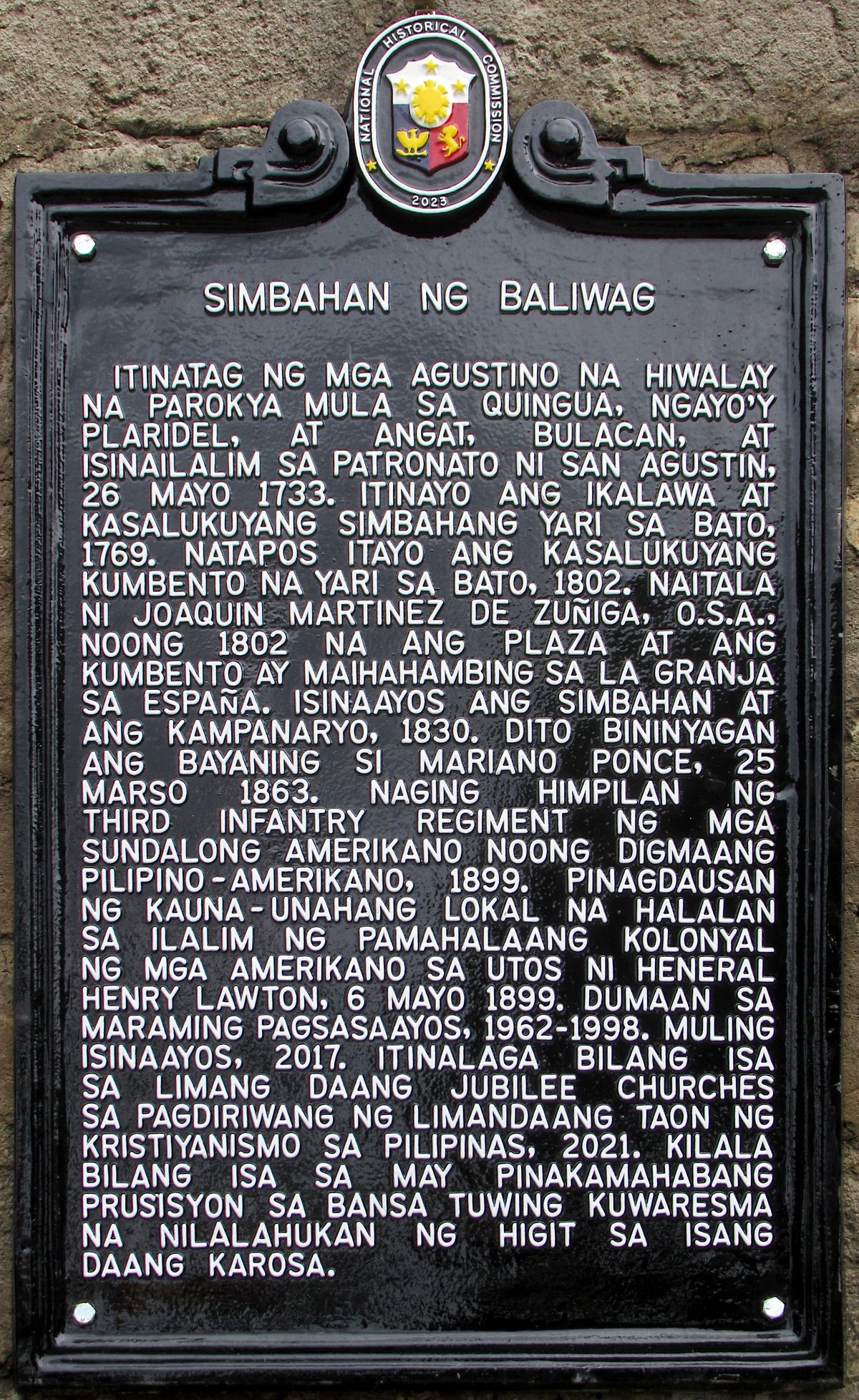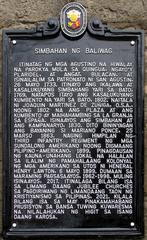
Church of Baliuag Historical Marker: Visiting Hours, Tickets, and Travel Guide
Date: 14/06/2025
Introduction
The Church of Baliuag, officially called the Saint Augustine Parish Church, is an enduring symbol of faith, history, and culture in Baliwag, Bulacan, Philippines. Founded in 1733 by Augustinian friars, this church is a masterpiece of Spanish colonial Baroque architecture and a living witness to centuries of local tradition, religious devotion, and civic transformation. Its grand façade, iconic bell tower, and intricately decorated interiors draw devotees, history enthusiasts, and tourists year-round. As the site of the Philippines’ first municipal elections under American rule in 1899, the church is not just a spiritual center but also a cornerstone of local and national history (Diocese of Malolos; Wikipedia).
This comprehensive guide details the church’s historical and cultural significance, architectural highlights, visiting hours, accessibility, and travel tips—ensuring a meaningful and well-prepared visit to the Church of Baliuag Historical Marker (baliwag.gov.ph).
Table of Contents
- Introduction
- Historical Overview
- Artistic and Cultural Heritage
- Visiting Information
- Location and Transportation
- Tips for Visitors
- Safety and Security
- Souvenirs and Local Products
- Responsible Tourism
- Frequently Asked Questions (FAQ)
- Summary and Final Advice
- References
Historical Overview
Early Foundations & Spanish Colonial Era
The Church of Baliuag was founded as an Augustinian parish on May 26, 1733, following its separation from Angat and Quingua (now Plaridel). Its first structure was a humble wood and thatch chapel near the Quingua River, following the era’s ecclesiastical traditions. In 1734, Baliuag was declared a vicariate under Father Manuel Baceta (Diocese of Malolos).
Architectural Evolution
As Baliuag flourished, so did its church. The wooden chapel was replaced by a stone-and-wood structure, and from 1863 to 1877, significant enhancements reflected the Spanish colonial Baroque style. The 1880 earthquake caused considerable damage, but reconstruction led by Padre Tomas Gresa gave the church its current cruciform layout with distinctive transepts, symbolizing Christ’s sacrifice (Diocese of Malolos).
Religious and Civic Significance
Dedicated to St. Augustine of Hippo—affectionately called “Apo Gusting” by locals—the church is the epicenter of Baliuag’s major religious events, particularly the grand annual fiesta each August and the iconic Holy Week processions. In 1899, it hosted the first municipal elections under American rule, marking its vital civic role (Wikipedia).
Surviving Wars and Natural Disasters
The church remarkably survived World War II and several earthquakes. While some artifacts were lost or damaged, its core structure and historical records remain intact (Diocese of Malolos).
Artistic and Cultural Heritage
The Church of Baliuag showcases a Baroque façade built of adobe and locally sourced bricks, a four-tiered bell tower, and a grand retablo gilded with gold leaf. The interiors feature trompe-l’œil ceiling paintings and antique religious images, including a recently restored San Agustin statue, which highlights the town’s historic lacework and craftsmanship (Tribune). The church also houses one of Bulacan’s oldest pipe organs and a collection of centuries-old liturgical artifacts and vestments.
The annual Holy Week processions, recognized for their scale and artistry, involve over 100 life-sized carrozas (floats) and are considered among the most elaborate in the country (Philippine Daily Inquirer). The Baliuag Lenten Festival and Buntal Hat Festival further highlight the church’s ongoing importance as a center for cultural heritage.
Visiting Information
Hours and Tickets
- Visiting Hours: Daily from 6:00 AM to 7:00 PM
- Mass Schedule: Typically 6:00 AM and 5:00 PM on weekdays; 6:00 AM, 9:00 AM, and 5:00 PM on Sundays and feast days
- Entrance Fee: None; donations for church maintenance are appreciated
Accessibility and Facilities
- Wheelchair Accessibility: Ramps and wide entrances are available; some areas (like the bell tower) may be challenging for those with mobility issues.
- Facilities: Restrooms, benches, and shaded areas are provided. Parking is available but limited during major events.
Guided Tours
Guided tours can be arranged through the parish office or Baliuag Tourism Office, especially during festivals and heritage events. Informal insights from parish volunteers are often available on site (baliwag.gov.ph).
Special Events
- Holy Week: Features the renowned Good Friday procession (audiala.com)
- Feast of St. Augustine: Held every August, includes processions, dances, and religious rites
- Buntal Hat Festival: Every May, celebrates local weaving traditions
Location and Transportation
The Church of Baliuag is centrally located in Plaza Naning, Baliwag, Bulacan—about 50 kilometers north of Metro Manila.
How to get there:
- Bus: Baliwag Transit and other lines from Cubao, Manila, and nearby terminals run direct to Baliwag (1.5–2 hours travel) (audiala.com)
- Jeepney/Van: Connects Baliwag to nearby Bulacan towns (kapampangantraveller.com)
- Train: Nearest station is Malolos; transfer to a jeepney or tricycle for a 30–45 minute ride to the church
Tips for Visitors
- Dress Modestly: Shoulders and knees should be covered inside the church.
- Photography: Permitted, but avoid flash and respect ongoing services.
- Quiet and Reverence: Maintain silence during Mass or prayers.
- Best Time to Visit: Dry season (November–April); Holy Week and major festivals for cultural immersion.
- Plan Ahead: Arrive early during events for parking and better viewing spots.
Safety and Security
Baliwag is generally safe and welcoming. Local authorities and parish staff provide security, especially during festivals. Keep valuables secure and remain vigilant in crowds. Local police and barangay offices are accessible for assistance (bulacan.gov.ph).
Souvenirs and Local Products
Support local artisans by purchasing:
- Buntal Hats: Handwoven hats unique to Baliwag (audiala.com)
- Religious Items: Rosaries, saint images, and sampaguita garlands
- Local Sweets: Pastillas de leche, ensaymada, and other Bulacan delicacies
Responsible Tourism
- Avoid touching historical markers or artifacts.
- Dispose of trash properly; help maintain church cleanliness.
- Respect local customs, and support local businesses and heritage preservation efforts.
Frequently Asked Questions (FAQ)
Q: What are the Church of Baliuag’s visiting hours?
A: Daily from 6:00 AM to 7:00 PM.
Q: Is there an entrance fee?
A: No, but donations are appreciated.
Q: Are guided tours available?
A: Yes, through the parish or Baliuag Tourism Office; informal tours may be available from volunteers.
Q: Is the church wheelchair accessible?
A: Mostly, but some areas may require assistance.
Q: When is the best time to visit?
A: November–April (dry season); Holy Week and festivals for unique experiences.
Q: How do I get there from Manila?
A: Take a bus to Baliwag or a train to Malolos and transfer to local transport.
Summary and Final Advice
The Church of Baliuag Historical Marker, embodied in the Saint Augustine Parish Church, is a vibrant testament to Bulacan’s religious, architectural, and community legacy. Its Baroque structure, historical significance, and living traditions make it a must-visit for pilgrims, heritage travelers, and anyone seeking a deeper understanding of Philippine culture.
To make the most of your visit:
- Check official schedules for the latest hours and events
- Dress respectfully and observe local etiquette
- Explore nearby attractions such as the Baliwag Museum and Library or the town’s heritage sites
- Support local artisans and businesses
For enhanced travel experiences, download the Audiala mobile app, follow official tourism channels, and participate in heritage preservation through conscious, respectful tourism. Your visit contributes to the ongoing stewardship of this cultural gem (Audiala).
References
- Diocese of Malolos
- Wikipedia: Baliwag Museum and Library
- Philippine Daily Inquirer
- Tribune: NHCP Restores Rediscovered Old Image of San Agustin
- Zenodo: Baliwag Historical Sites
- National Historical Commission of the Philippines: Historical Markers List
- Baliwag Municipal Government: Tourism Page
- Audiala: Baliwag Travel Guide
- touristplaces.guide: Top 10 Must-Visit Tourist Places in Bulacan
- bigwas.com: Saint Augustine Parish Church
- Baliuag Tourism Office Facebook
- Philippine Heritage Map
- Bulacan Provincial History
- National Museum of the Philippines
- kapampangantraveller.com: Baliwag Heritage Walkthrough
- trek.zone: Baliuag
- nhcphistoricsites.blogspot.com: Simbahan ng Baliwag
- bulacan.gov.ph: Baliwag City

